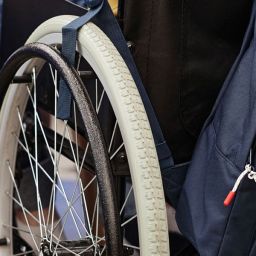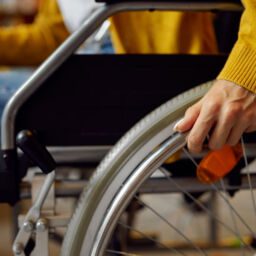Since transferring to Cal Poly Humboldt in 2021, Christine DiBella says she has been challenged to navigate inaccessible spaces. She was aware of the hills and stairs before she moved, but never had any issue conquering hills with her power wheelchair while attending San Francisco City College. Her main struggle has been with a lack of safety. When her dorm practiced emergency drills, she was excluded and advised to coordinate her own exit with help from other students. DiBella is suing the California State University system for its lack of emergency evacuation plans for students like herself.
“It’s hard to focus when I know there’s no plan for me,” DiBella said. “We’ve had storms cause the power to go out, the elevator has been down for weeks, and I ask, ‘What’s the plan for me,’ and I’ve never gotten an answer.”
DiBella’s attorney Cat Cabalo says this issue is not specific to Cal Poly Humboldt’s campus. She emphasized these barriers reflect decisions that did not include or prioritize students with disabilities.
“Of the four points of emergency planning that are required per the DOJ technical guidance, we could not find one campus that had met the requirement to allow for participation in drills,” Cabalo said.
According to CSU’s most recent data, there are more than 1,500 students with physical limitations that require accommodation in the event of an emergency on CSU’s 23 campuses.
“As people without disabilities, we take for granted that we have ways of getting out of the situation and ways of participating meaningfully in drills. That is something that is woefully absent for [students with disabilities] throughout the entire CSU system,” Cabalo said.
CPH has one of the largest disabled student populations in the CSU system at 9.6 percent, behind only Cal State Maritime Academy. Despite this statistic, Humboldt has limited staff in the Student Disability Resource Center (SDRC). At California State University at San Bernardino, the ratio of accessibility advisors to students is one to 65. At CPH, the ratio is one to 500.
When her dorm practiced evacuation drills, DiBella said she emailed the housing office ahead of time to ask how she could be included. In response, she said, the university instructed her to connect with other students in College Creek so they would be prepared to help her in the case of an emergency — despite the building being constructed in 2011, three decades after the Americans with Disabilities Act was passed, requiring safe exits for people with disabilities.
“I was told there are evacuation chairs. When they housed me on the third floor, I was concerned. I asked, ‘Where are the evacuation chairs? What do I need to do in an emergency?’ and no one would get back to me,” DiBella said. “Their route for me to get out required me to go through three elevators. In a real emergency, there is no option for me.”
“I honestly didn’t know a state building could be this bad,” DiBella said. “Before I came [to CPH], access was not a concern. I’m lucky to live in a post-ADA world where I have a normal experience. But at this school, I’m constantly directed to disability-only activities.”
So, she filed a class action civil rights suit against the CSU system. The suit alleges CPH is violating Title II of the ADA and the Federal Fair Housing Act by failing to provide accessible facilities, excluding her from student social events, and lacking emergency evacuation plans for disabled students. DiBella’s case argues that if the CSU were more inclusive, they would be safer, that the the exclusion of students with disabilities puts them in harm’s way. A class action suit is brought by a group of more than 40 members who are harmed by the same circumstances, and if the class is certified, any CSU student with a disability may join the case.
Spokesperson for the CSU Amy Bentley-Smith says the system looks forward to addressing DiBella’s claims. The CSU challenged the certification of the class, meaning it doesn’t believe every CSU student with a disability is in the same situation as DiBella. Since DiBella’s case alleges issues CSU-wide, her suit must prove all 23 campuses lack emergency accommodation.
“The CSU values safety and inclusion and is committed to providing a positive and meaningful experience for all students,” Bentley-Smith writes in a statement emailed to the Journal. “We disagree with the allegations and plaintiff’s characterization. The CSU and its 23 campuses maintain publicly available emergency evacuation plans.”
DiBella says she experiences accessibility issues every day — from accessing the dining hall and commuting to classes to doing laundry on campus and using the recently renovated library. On several occasions, DiBella said, she was trapped in buildings when automatic door buttons worked upon entering but not when she tried to exit.
Just to get to the Jolly Giant Commons dining hall for breakfast, DiBella had to travel convoluted routes twice the distance of an able-bodied student’s walking path to circumnavigate the stairs throughout campus.
“A daily experience would be going to the J to get food and the elevator to the JGC would be down. It would be 7 a.m. No one would be there to help me, so I wouldn’t have food in the morning,” she said.
Even when the elevator did work, DiBella said the accessible entrance to the dining hall would often be locked, while the revolving door she’s unable to use was open for everyone else.
“On a daily basis, I’m writing emails asking for access, for basic things, equal access that should be covered by the ADA,” DiBella said. “I’d send email after email asking to be included, and I don’t hear back. It seems like I’m doing 100 times the work of the average student, and I’m still being excluded.”
At one point, DiBella said the administration asked her to stop sending emails because she was harassing campus faculty. She said she was often referred to the SDRC, which facilitates accommodations for academic success — things like getting professors to allow extra time on exams — and provides transportation for students with disabilities. But in DiBella’s view, the SDRC is not supposed to be responsible for her needs. Her needs, she says, are civil rights codified by the ADA. And when she did try to organize transportation with the SDRC, DiBella said their van was inadequate and attempting to use it damaged her power wheelchair.
“Unfortunately, the van [SDRC] uses is a personal-use minivan. It’s not a paratransit vehicle like [the ones] every other agency I’ve worked with has provided,” DiBella says. “It does not fit my wheelchair. Even if it did fit, there is no wheel lock, and there are not proper straps. So it’s unsafe.”
In October of 2021, DiBella said she reached out to the Office of the State Fire Marshal, informing the agency that she’d been asked to coordinate her own evacuation plan. The office cited Cal Poly Humboldt for failing to address emergency planning issues for disabled students and directed the university to relocate DiBella immediately. CalFire and the office of the State Fire Marshall were unable to comment on the pending litigation.
DiBella also reached out to local disabilities advocate and emergency planning coordinator Dawn Albrecht for support. DiBella’s emails to Albrecht were included in the complaint, but Albrecht did not respond to attempts of contact for this story. In their correspondence, Albrecht said she had talked to the school about their inadequate planning in 2014. She brought up a lack of adequate planning for evacuating individuals with mobility issues from upper floors on campus, a lack of med sleds and other evacuation devices or individuals trained to use them.
“The fact that they would still put a student in a wheelchair on the third floor is ridiculous,” Albrecht said in an email to DiBella in 2021. “Then they want to turn it around on you and make you responsible for their flawed building design, thoughtless room assignments, lack of adequate planning … I could go on, but it would do no good. Providing a list of students with disabilities to firefighters is inadequate and simply passing the buck instead of taking individual student needs into consideration.”
DiBella is seeking to bring awareness and assistance to emergency accommodation to all CSU campuses. In the first week of June, the CSU requested that the court limit the scope of and set a new deadline for its response to DiBella’s third amended complaint.
On June 20, after multiple extensions, the CSU Board of Trustees answered DiBella’s complaint, denying a majority of the allegations, including that CPH asks students with disabilities to coordinate their own evacuation. However, the university’s evacuation procedures page suggests, “Persons with mobility impairments or using wheelchairs should prepare for emergencies ahead of time by instructing classmates or faculty on how to assist her/him in case of emergency.” The defendants do admit not all CSU campuses have evacuation chairs. They also assert there is no state or federal law requiring them to alter programs to accommodate DiBella.
Source: northcoastjournal.com, Ollie Hancock
Disability Discrimination Lawyer | ADA Lawsuits | FREE Consultations
The Americans with Disabilities Act (ADA) is a piece of civil rights legislation that prohibits discrimination against people with disabilities in workplaces, schools, transportation, and essentially all areas of public and private life. The ADA also guarantees that people with disabilities have equal opportunity in public accommodations, places of employment, state and local government services, transportation, and telecommunications. It’s imperative to have an experienced ADA lawyer on your side. Contact Us Today by calling 415-766-3545 or by filling out an online Contact Form for a FREE Consultation.







